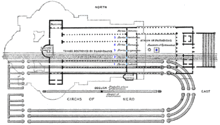- Circus of Nero
-
Coordinates: 41°54′5.82″N 12°27′14.94″E / 41.9016167°N 12.45415°E
- Not to be confused with the older and larger Circus Maximus.
The Circus of Nero or Circus of Caligula was a circus in ancient Rome.
Contents
Construction
It was begun by Caligula on the property of his mother Agrippina on the Ager Vaticanus (today's rione of Borgo), and finished by Nero. The circus building's alignment is on the same axis as both new and old St Peter's to the left as you look at the western front from the piazza.
Nearby Roman cemetery
See also: Saint Peter's tomb and Vatican NecropolisThe Via Cornelia ran parallel with the north side of the Circus, and its course can be traced with precision, for pagan tombs have been discovered at various times along its edges. Sante Bartoli's memoirs record that when Alexander VII was building the left wing of Bernini's colonnade and the lefthand fountain, a tomb was discovered with a bas-relief above the door representing a marriage-scene ("vi era un bellissimo bassorilievo di un matrimonio antico"). Others were soon found. The best discovery, that of pagan tombs exactly on the line of St Peter's tomb, was made in the presence of Grimaldi, 9 November 1616:
- "On that day, I entered a square sepulchral room the ceiling of which was ornamented with designs in painted stucco. There was a medallion in the centre, with a figure in high relief. The door opened on the Via Cornelia, which was on the same level. This tomb is located under the seventh step in front of the middle door of the church. I am told that the sarcophagus now used as a fountain, in the court of the Swiss Guards, was discovered at the time of Gregory XIII in the same place, and that it contained the body of a pagan."
Place of martyrdom
Main article: Saint Peter's tombThe circus was the site of the first organized, state-sponsored martyrdoms of Christians in 65. Tradition holds that two years later, Saint Peter and many other Christians shared their fate. The circumstances were described in detail by Tacitus in a well-known passage of the Annals, (xv.44).
The site for crucifixions in the Circus would have been along the spina ("spine"), as suggested by early Acts of Peter describing the spot of his martyrdom as inter duas metas ("between the two metae or turning-posts", which would have been equidistant between the two ends of the circus). This identification is likely to be genuine given the trauma of the event for the Christian community.[citation needed] An obelisk found at the centre of this circus's spina was re-erected in Saint Peter's Square in the 16th century by the architect Domenico Fontana. The obelisk was originally brought to Rome by Caligula.
The traditional location of Saint Peter's tomb is in this area, in the cemetery mentioned above and on a site suggested by the basilica (see below).
Constantine's basilica
Main article: Old Saint Peter's BasilicaA basilica (Old St. Peter's) was erected by Constantine over the site, using some of the existing structure of the Circus of Nero. The basilica was sited so that its apse was centered on Peter's tomb (now beneath the high altar of "New St Peter's").
External links
- Lacus Curtius website: Circus of Nero, plan superposed with the Basilicas, showing the tomb of Peter, and text by Rodolfo Lanciani describing the largely inadvertent archaeology
Categories:- Ancient Roman circuses in Rome
Wikimedia Foundation. 2010.



